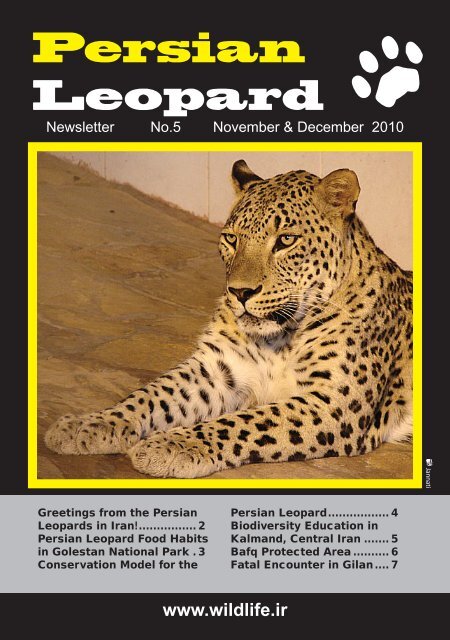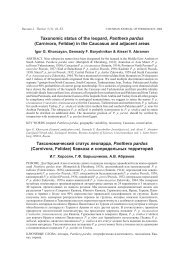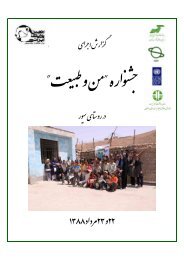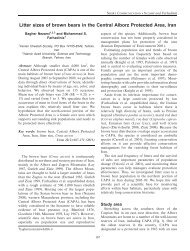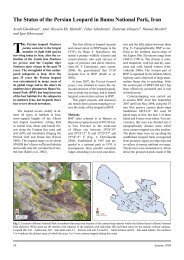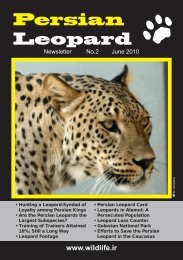Persian Leopard
Persian Leopard
Persian Leopard
You also want an ePaper? Increase the reach of your titles
YUMPU automatically turns print PDFs into web optimized ePapers that Google loves.
<strong>Persian</strong><br />
<strong>Leopard</strong><br />
Newsletter No.5 November & December 2010<br />
Jannati<br />
Greetings from the <strong>Persian</strong><br />
<strong>Leopard</strong>s in Iran! ................ 2<br />
<strong>Persian</strong> <strong>Leopard</strong> Food Habits<br />
in Golestan National Park . 3<br />
Conservation Model for the<br />
<strong>Persian</strong> <strong>Leopard</strong> ................. 4<br />
Biodiversity Education in<br />
Kalmand, Central Iran ....... 5<br />
Bafq Protected Area .......... 6<br />
Fatal Encounter in Gilan .... 7<br />
www.wildlife.ir
<strong>Persian</strong><br />
<strong>Leopard</strong><br />
Greetings from the <strong>Persian</strong><br />
<strong>Leopard</strong>s in Iran!<br />
This issue of the <strong>Persian</strong> <strong>Leopard</strong><br />
Newsleer is different in just a<br />
single page, compared to previous<br />
volumes. The year is changing to 2011<br />
in a few days so we have commied to<br />
change our style in order to share with<br />
you, definitely, the happiest moment for<br />
us at the Iranian Cheetah Society (ICS) in<br />
the Year of <strong>Leopard</strong>!<br />
This is the story: Since early 2010, ICS has<br />
been producing a documentary movie<br />
about the <strong>Persian</strong> leopard in Iran. Recently,<br />
the ICS film crew was successful to capture<br />
an impressive long<br />
shot of an adult male<br />
in Golestanak Reserve!<br />
The area hosts intensive<br />
research programs on<br />
brown bear as well as the<br />
leopard since 2005 (you<br />
can read about this study<br />
on the volume 3, August<br />
2010). Aer connuous<br />
tracking by the biologists,<br />
a passive HD camera trap<br />
designed by an Iranian<br />
technician was quite<br />
helpful to trap the animal<br />
while exhibing his territorial behavior.<br />
The animal is on a scrape, urinang and<br />
defecang, and then it sniffs and licks<br />
another scrape, possibly to find a mate! It<br />
was a big success for all of us before the<br />
end of 2010 as the year of leopard in Iran<br />
and encourages our film crew to work much<br />
more to produce a presgious movie.<br />
We would like to thanks you all for any<br />
kind of supporng and wish you peace and<br />
prosperity this holiday. Season’s greengs<br />
and merry Christmas to our in-holiday<br />
friends!<br />
Passive HD camera-trap/ICS<br />
2<br />
Newsletter No.5<br />
Nov. & Dec. 2010
<strong>Persian</strong><br />
<strong>Leopard</strong><br />
<strong>Persian</strong> <strong>Leopard</strong> Food Habits in<br />
Golestan National Park<br />
The study entled “the <strong>Persian</strong><br />
leopard diet in different landscapes<br />
of Golestan Naonal Park (GNP)”<br />
conducted during February 2009 to<br />
February 2010, as the Master thesis of ICS’<br />
research associate, Elmira Shaerbafi.<br />
The carnivore’s diet depicts their likely<br />
potenal preys as<br />
Shakiba<br />
well as behavioral<br />
and physiological<br />
adaptaons of a species.<br />
It is also important in<br />
parcular about the<br />
apex predators like the<br />
leopard, to understand<br />
their feeding ecology in<br />
order to guarantee the<br />
species survival in the<br />
frame of saving its prey.<br />
The most effecve<br />
method for this kind<br />
of studies is ‘field<br />
observaons’ which is<br />
not always performable.<br />
So, faecal analysis was<br />
used to define the animal food habits. 115<br />
scat samples which were used in this study,<br />
showed a significant difference between the<br />
frequency of preys which were used by the<br />
leopard. The dominant prey items in the scats<br />
were remains of the wild boar Sus scrofa and<br />
the wild sheep Ovis orientalis, respecvely.<br />
This is also approved according to the direct<br />
observaons by GNP’s<br />
game wardens.<br />
There was no significant<br />
difference between the<br />
dry and wet seasons,<br />
neither in steppe<br />
and forest habitats.<br />
results of this study.<br />
Furthermore, during<br />
stomach and intesne<br />
analyses of two subadult<br />
leopards which<br />
had been killed in road<br />
incidents inside the<br />
park, Indian crested<br />
porcupine Hystrix indica<br />
remains were found<br />
intensively. A paper is in<br />
preparaon to release<br />
Shaerbafi<br />
Zamani<br />
Newsletter No.5<br />
Nov. & Dec. 2010<br />
3
<strong>Persian</strong><br />
<strong>Leopard</strong><br />
Conservation Model for the <strong>Persian</strong> <strong>Leopard</strong>:<br />
Sarigol National Park, Northeastern Iran<br />
The endangered <strong>Persian</strong> leopard has<br />
recently aracted numerous research<br />
efforts in Iran; however, it is highly<br />
important that research projects support<br />
and improve the conservaon status of<br />
the cat’s habitats. Established in 2005, the<br />
Project <strong>Persian</strong> <strong>Leopard</strong> in Sarigol Naonal<br />
Park is the oldest, but sll ongoing, effort in<br />
Iran to save the species. It is composed of<br />
Camera Trap/ICS<br />
three main strands which aim to promote<br />
conservaon of the area. Ecological<br />
research was mainly conducted within<br />
the naonal park to explore populaon<br />
parameters, food habits, reproducon,<br />
and prey demographics. At the same<br />
me, research was carried out in local<br />
communies, a partnership was formed<br />
with local stakeholders and educaonal<br />
programs were implemented.<br />
Finally, the project results were<br />
reported to the Department of<br />
Environment for consideraon<br />
in formulang protecon<br />
measures.<br />
A complete report about lessons<br />
learned from Sarigol leopard<br />
project has been published in<br />
autumn 2010 issue of IUCN/SSC<br />
Cat Specialist Group’s Cat News<br />
which soon will be available on<br />
the ICS website.<br />
4<br />
“Save the Vanishing<br />
<strong>Leopard</strong>s” on Radio<br />
In November 2010, ICS’ Managing<br />
Director, Morteza Eslami, featured<br />
on a special program in Farhang (=<br />
culture) Radio about the <strong>Persian</strong> leopard<br />
and Asiac cheetahs in Iran. Morteza<br />
discussed the cheetah status from past<br />
to now, the animal potenal preys and<br />
its known habitats in the country. He<br />
also described threats that the <strong>Persian</strong><br />
leopards are already facing in their last<br />
stronghold. ICS’s educaonal acvies in<br />
the Year of <strong>Leopard</strong> were another issue<br />
to be presented by Morteza in this public<br />
media.<br />
Newsletter No.5<br />
Nov. & Dec. 2010<br />
<strong>Leopard</strong> Footage<br />
Mirza Karimi<br />
Kuh-Sefid PA, which is located in Damavand<br />
territory and is extended to Semnan<br />
province borders, is known for rare shots<br />
of a Pallas cat in late 2008. Recently, movie of a<br />
leopard from the area has put it in top wildlife<br />
news of the month. The animal was roaming on<br />
a sheer cliff, when Abbas Mirza Karimi - head of<br />
Damavand office of DoE - captured a movie of<br />
the enigmac cat. The movie is long enough to<br />
show the animal in a nice close view.
<strong>Persian</strong><br />
<strong>Leopard</strong><br />
Biodiversity Education in Kalmand, Central Iran<br />
The Kalmand-Bahadoran<br />
Protected Area (KBPA) is<br />
the home for developing<br />
biodiversity educaonal<br />
acvies, which is launched<br />
in March 2010. KBPA is one<br />
of the main hotspots of the<br />
endangered <strong>Persian</strong> leopard in<br />
Central Iran and is considered to<br />
be among the last refuges of the<br />
crically endangered Asiac cheetah in Iran. The<br />
project is supposed to focus on local residents of<br />
the Mehriz town, as well as relevant villages.<br />
A variety of threats have been<br />
idenfied in this area affecng<br />
adversely survival of the species<br />
with poaching and habitat loss as<br />
the most important. Moreover,<br />
impact of the main regional transit<br />
rout - which is passed through the<br />
area - on the KBPA’s biodiversity, is much cricized<br />
over recent years because of confirmed death of<br />
5 Asiac cheetahs in road incidents. Therefore,<br />
Updates for the <strong>Persian</strong><br />
<strong>Leopard</strong> Library!<br />
New documentaons on leopards in<br />
Iran have been added to the <strong>Persian</strong><br />
leopard bibliography at the ICS’<br />
website. Also, Dr. Colin Groves kindly helped<br />
us to prepare an e-copy of Zukowsky’s 1964<br />
renowned paper on the subspecies of<br />
leopards, including the <strong>Persian</strong> leopard.<br />
CACP/Yazd DoE<br />
with respect to poaching which<br />
has been boosted up recently<br />
by local youths in KBPA, the<br />
educaonal program was started<br />
by the Iranian Cheetah Society<br />
(ICS). Hence, this project is<br />
training people in different age<br />
groups associated with relevant<br />
problems in the area in order<br />
to protect regional biodiversity<br />
and important species, especially the big cats.<br />
Negoang with local stakeholders and developing<br />
the baseline of site’s socio-economic informaon<br />
had been the inial steps of<br />
conducng this project. Also,<br />
similar experiences of the past ICS’<br />
project in Bafq were shared with<br />
local partners to be more familiar<br />
Babrgir<br />
with the project trend. KBPA’s<br />
game wardens were recognized<br />
to be highly essenal in success of the project, so<br />
they were asked to prepare the project’s goals and<br />
outcomes. Finally, the project was connued in local<br />
schools, aer preliminary knowledge assessment to<br />
measure the project’s impact aer the workshops.<br />
Meanwhile, six field-visits for all local students<br />
has been planned to visit the area and learn more<br />
praccally about its rich biodiversity. Their teachers<br />
will be also trained by the ICS’ educators to become<br />
more environmental-friendly teachers.<br />
The Kalmand educaonal project is implemenng<br />
with cooperaon of Yazd Department of<br />
Environment with inial funding from Royal Dutch<br />
Embassy in Tehran and will last unl spring 2011<br />
<strong>Leopard</strong> Loss Counter (november & december 2010)<br />
In a strange case, a male leopard found dead on a<br />
high-voltage power line in Northeastern Iran. The<br />
animal was obviously shot by poachers but the whole<br />
story is still unclear. Another leopard is also confirmed to<br />
being poached in the Caspian region. Moreover, rumors<br />
claim two leopards were shot in Southern Iran.<br />
Razavi Khorasan DOE<br />
Newsletter No.5<br />
Nov. & Dec. 2010<br />
5
<strong>Persian</strong><br />
<strong>Leopard</strong><br />
Bafq Protected Area<br />
The 88527ha (Kuh-e) Bafq Protected Area<br />
(BPA) is designated at the northeast of<br />
Yazd Province, Central Iran. The area is<br />
parcularly a great mountainous range with<br />
some 70 Kilometers long and owns sparse plains<br />
and rolling hills. Extraarid<br />
and arid climates<br />
are dominants in<br />
BPA but vegetaon<br />
cover is moderately<br />
rich. Basically, BPA is<br />
Khajeh<br />
well-known for a tragic<br />
event for cheetahs of<br />
Iran. On 31 August 1994, a few months old cheetah<br />
cub along with her two sisters and mother came to<br />
a spring adjacent to the city of Bafq to drink some<br />
water in a hot noon. Unfortunately, the family was<br />
aacked by some local people,<br />
the mother run away and just<br />
‘Marita’ was rescued out of<br />
the three young cheetahs.<br />
Marita lived in Pardisan Park<br />
ll 2003, as the only capve<br />
Asiac cheetahs in the world.<br />
Since 2007, the Cheetah Day<br />
has been celebrated by various<br />
Iranian NGOs and the Iranian Department of the<br />
Environment (DoE)’s Conservaon of the Asiac<br />
Cheetah Project (CACP) in which numerous<br />
educaonal programs were held inside the main<br />
cies as well as local communies around the<br />
cheetah habitat.<br />
BPA is a good leopard country in such arid<br />
environment in Central Iran. The area supports<br />
healthy population of <strong>Persian</strong> ibex and wild sheep<br />
which could sustain<br />
leopards. The animal is<br />
captured several times<br />
by game wardens,<br />
most recently in<br />
October2010 on an ibex<br />
kill. Meanwhile, other<br />
carnivores including<br />
the secretive caracal, grey wolf, stripped hyena and<br />
golden jackals occur in the area. The first ever radiotelemetry<br />
study in Iran also was conducted in BPA,<br />
in collaboration between CACP, DoE, UNDP, WCS,<br />
Panthera and ZSL by capturing<br />
2 adult cheetahs and a male<br />
leopard in 2007. However, one<br />
of the cheetahs killed - probably<br />
- by a resident leopard a few<br />
months later and the second<br />
animal was lost after finding its<br />
Khajeh<br />
Karimi<br />
radio-collar without any signs.<br />
The leopard was tracked before<br />
dropping its collar which gave scientists the first data<br />
on the subspecies’ ranging patterns.<br />
See Hunter et al. (2007) for more informaon<br />
concerning this project.<br />
6<br />
Teymouri<br />
Newsletter No.5<br />
Nov. & Dec. 2010
During early July 2008, while patrolling<br />
Deylaman No-Hunng Area up in<br />
forested mountains of Gilan Province,<br />
northern Iran, foresters encountered fresh<br />
body of a young male leopard on a trail with<br />
fresh kill of an adult female Maral red deer<br />
hidden among bushes. As reported to Gilan<br />
office of Department of the Environment<br />
(DoE), local experts visited the area and set<br />
two camera traps.<br />
They expected to<br />
capture another<br />
leopard as signs<br />
of a bigger animal<br />
were seen there.<br />
They were right and<br />
the animal guilty in<br />
charge was phototrapped!<br />
It was an<br />
adult male who<br />
was supposed to<br />
kill the young male<br />
yesterday.<br />
According to Balme 2010; male leopards are<br />
territorial, defending a defined home range<br />
that contains sufficient resources to ensure<br />
<strong>Persian</strong><br />
<strong>Leopard</strong><br />
Fatal Encounter in Gilan<br />
their survival and, more importantly, access<br />
to reproducve females. Such defense is<br />
normally passive: an individual adverses<br />
his presence by means of scent marking or<br />
a disncve rasping call. Familiar neighbors<br />
recognize one another and generally respect<br />
each other’s boundaries. But problems arise<br />
when a newcomer enters the scene.<br />
<strong>Leopard</strong>s fatal combats have been already<br />
reported from<br />
CameraTrap/ Gilan DoE<br />
other parts of Iran,<br />
especially from<br />
Tandureh and<br />
Golestan Naonal<br />
Parks (two of the<br />
highest density<br />
leopard populaons<br />
in the country) when<br />
body of males were<br />
found with obvious<br />
signs of serious<br />
injuries, but it was<br />
for the first me that<br />
such an aggressive intra-sexual interacon<br />
has been confirmed across the <strong>Persian</strong><br />
leopard range in Iran.<br />
Gilan DoE<br />
Gilan DoE<br />
Newsletter No.5<br />
Nov. & Dec. 2010<br />
7
Special thanks to …<br />
The Iranian Cheetah Society (ICS) would<br />
like to thank the following people and<br />
organizations for their generous support<br />
to save the <strong>Persian</strong> leopards in Iran:<br />
‣ Amersfoort Zoo, the Netherlands<br />
‣ Conservation des Espèces et des<br />
Populations Animales (CEPA), France<br />
‣ Parc des Felins, France<br />
‣ People’s Trust for Endangered<br />
Species (PTES), UK<br />
‣ Prins Bernhard Natuur Fonds,<br />
the Netherlands<br />
‣ Royal Dutch Embassy in Tehran<br />
Newsletter Editorial Team:<br />
‣ Ehsan M. Moqanaki<br />
‣ Mohammad S. Farhadinia<br />
‣ Elmira Shaerbafi<br />
‣ Saba Sohrabinia<br />
Layout:<br />
‣ Hamidreza Mirzadeh<br />
Contact us on:<br />
persianleopard@wildlife.ir<br />
Iranian Cheetah Society (ICS) is a non-governmental,<br />
non-profitable organization devoted to save the biodiversity<br />
which is so rich, but disappearing in Iran. Carnivores have<br />
essential priority within the ICS activities and various<br />
research and conservation projects have been implemented<br />
on the species, such as Asiatic cheetah, brown bear, striped<br />
hyeana, grey wolf, Eurasian lynx, caracal, mustelids and<br />
<strong>Persian</strong> leopard whose more than two third of its wild<br />
population occurs in Iran. It has been established in 2001<br />
(registration number 13640) and hopes to celebrate its first<br />
decade of biodiversity conservation soon.<br />
To learn more about Iranian Cheetah Society (ICS)<br />
visit: www.wildlife.ir


